Burns
It is an injury to body tissue caused by heat, chemicals or radiation.
Types of Burns
- Dry burn - burn caused by flames, lighted cigarettes and hot electric equipment
- Scalds - Burns caused by wet heat such as steam, hot water, or fat produced scalds
- Cold burn - burn due to contact with substances such as liquid oxygen & liquid nitrogen
- Chemical burns - Caused by acid or alkalis chemicals
- Electric burn - Eclectic current and lightning generate heat and can cause burns.
- Radiation burn - Sun rays and light reflected from the bright surface.
Classification of burns- Classified according to the area and depth of the injury
Superficial or 1st Degree Burns
- Involves only the outer layer of the skin (see Figures 37-38, below).
- Sign and symptoms: Redness, swelling and tenderness.
- Immerse in cold water.
- Remove any rings watches and coverings from the injured site.
- Dress with a clean dressing.
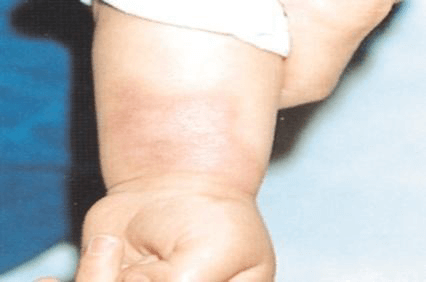
Fig. 37. A superficial burn.
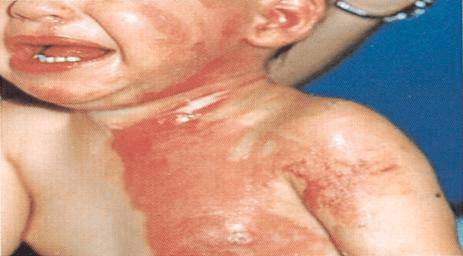
Fig. 38. A superficial burn.
Intermediate or 2nd Degree Burns
- involves the formation of a blister (see Figures 39-40, below)
- Sign and symptoms: Swollen and red. It can be infected
- Lay the causality down and check ABC
- Protect the burn area forms contact.
- Remove any ring watch etc.
- Don not removes anything that is sticking to a burn.
- Cover the area with a sterile dressing.
- Do not apply any ointment or lotion.
- Do not break blisters.
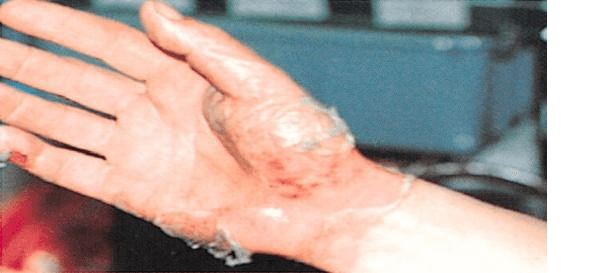
Fig. 39. Partial thickness burn.
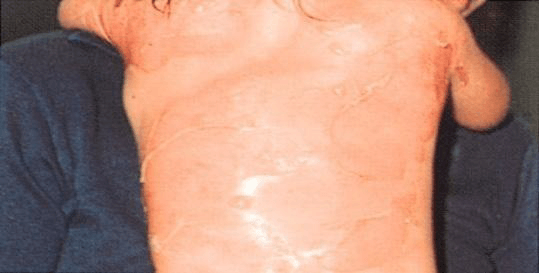
Fig. 40. Partial thickness burn.
Deep or 3rd Degree Burns
- Involves all layers of the skin (see Figures 41 & 42, below).
- Sign and symptoms: The skin appears pale, waxy or charred.
- Relatively pain-free b/s damaged nerves.
- Deep burn always requires medical attention.
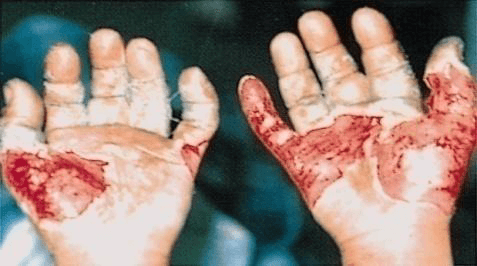
Fig.41. Full-thickness burns.
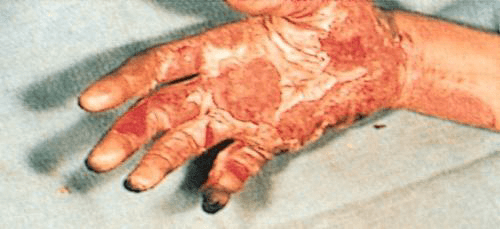
Fig. 42. Full-thickness burns.
First Aid Measures
- Lay the causality down and checks ABC.
- Protect the burn area forms contact.
- Remove any ring watch etc.
- Don not removes anything that is sticking to a burn.
- Cover the area with a sterile dressing.
- Do not apply any ointment/ lotion.
- Do not break blisters.
- Rinse irrigate chemical burn with clean water.
Bandages
- Bandages are strips of woven material used to hold a wound dressing or splint in place.
- It helps to immobilise, support and protect an injured part of the body.
Types of Bandages
- Elastic bandage.
- Gauze bandages.
- Triangular bandages (for the scalp, foot or any large areas and for sling).
- Adhesive strip bandages (for small wounds following through cleaning).
General Principles of Application of Bandages
- A bandage should be not too loose or too tight.
- Ensure that circulation is not interfered.
- Leave the victim fingertips and toes exposed.
- Watch for swelling, change of color and coldness of the tips of fingers or toes indicating interference with circulation.
- Loosen bandages immediately if the victim complains of numbness or tingling sensation.
Methods of Applying Bandages
Arm Sling
- Prepare a triangular bandage.
- Place one end of the bandage over the injured shoulder and let the other end hang down in front of the chest parallel to the side of the body.
- Carry the point behind the elbow of the injured arm.
- Carry the second end of the bondage up over the shoulder and the two ends together of the side of the neck not over the spine.
- Bring the point of the sling and tie it.
- Make sure the ends of the fingers extend just beyond the base so that you can observe whether or not the circulation is cut off.
- In all cases of forearm or hand injury adjust the sling so that the hand is elevated 10 or 12 cm a have the level of the elbow.
Last modified: Sunday, 13 November 2016, 10:31 AM